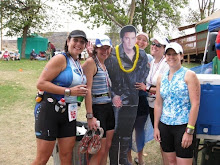Windy City Sports
If you're a runner who doesn't strength train, then I can almost guarantee that the question isn't if, but when you'll be sidelined due to injury.
The old belief that runners don't need to (and shouldn't) lift weights is outdated and usually put forth by runners who will defer marathon entries due to injury and/or become what I call "accidental triathletes" -- runners forced to swim and bike to rehabilitate running-related injuries.
I contend that running doesn't cause injuries, but rather illuminates our weak links and allows us to see what we need to improve upon. There's no greater way of determining how to improve our bodies than by listening to and accessing how we respond to running.
By pinpointing our weaknesses and working on strengthening them early on in life, we can build a strong musculoskeletal system that will carry us through our later years with little or no pain.
The problem with strength training and runners is that most have absolutely no idea what, when or how often to do it. The basic keys are as follows: runners need to lift weights consistently, correctly and at the right intensity:
- Consistently means two or three times a week for several months to truly begin to build a proper base of strength.
- Correctly refers to performing the exercises in a safe and effective manner with proper technique and muscle control.
- Right intensity relates to the amount of weight used for each exercise as well as the difficulty of each training session.
What many runners don't seem to realize is that they're lifting for injury prevention and running performance and these sessions aren't like the workouts you would do to simply look good. These are not vanity workouts, where toning and building muscle is the end goal.
Rather, these workouts are focused first and foremost on strengthening weak muscle groups and creating balance throughout the entire body. These workouts need not be long with multiple sets for each exercise. Many of these exercises are multi-joint exercises, ones that work several muscle groups at a time, thereby reducing the time needed for each workout.
Strength-training exercises
These exercises incorporate unilateral movements and unstable surfaces to more closely approximate the biomechanics of running. They'll improve your running economy, leg strength, balance and coordination, and work stabilizer muscles while helping to eliminate muscular imbalances. Perform one to two sets of 15 repetitions of each, one to three times a week.
1. One-legged ball squats
Stand on one leg with a stability ball pressed against a wall with your back. Slowly squat to just above 90 degrees of knee bend, pause, then return to start position. Be sure to keep your knee behind your toes throughout the exercise (shown above).
2. Balance board split squats
Stand with one foot on a circular balance disc (a Bosu will also work). Bend your leg to just above 90 degrees of knee bend, pause, then return to start position. Be sure to keep your knee behind your toes throughout the exercise. You can also hold dumbbells or place your back leg up on a bench for added difficulty.
3. One-legged dumbbell deadlifts
This is one of the harder exercises to maintain proper form. Stand on one leg while holding dumbbells with knee slightly bent and shoulders pulled back. Bend slowly at the waist, making sure to keep your shoulders back and your back from rounding.
Pause when you feel a tightness in the back of your legs (with dumbbells roughly halfway down your shins) pause, then return to start position. You may do this exercise without weights until you're accustomed to the movement, then add dumbbells.
Reprinted, courtesy of Windy City Sports Magazine.





















No comments:
Post a Comment